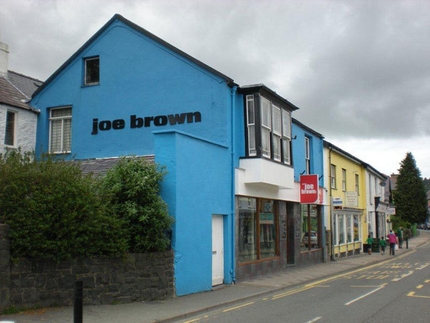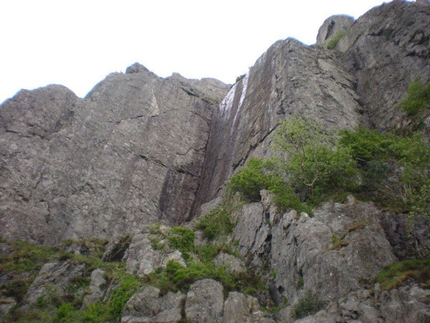Goodbye to British climbing legend Joe Brown

 1 / 10
1 / 10 Ray Wood
Ray Wood
Joe Brown, one of world’s greatest all-round climbers, passed away peacefully at his home in Llanberis, Wales, last night. Born in Manchester on 26 September 1930 the youngest of seven children, Brown left school aged 14 and served an apprentice as a builder before pioneering hundreds of climbs during the 1950’s and 60’s throughout Great Britain, the Himalaya and Greater Ranges. Such was his reputation that for many years letters were sent to him addressed simply to "The Human Fly, UK."
Brown started exploring the nearby gritstone outcrops of the Peak District at an early age and quickly discovered his love and talent for climbing. His first routes date back to the immediate post-war period with all-time classics such as Three Pebble Slab, Brown’s Eliminate and Valkyrie at Froggatt, and Right Unconquerable at Stanage being established in 1948 and 1949. After an enforced 18-month stop due to National Service he returned to forging new rock climbs across Britain that contributed to a significant rise in standards. His climbs were rarely inspected or cleaned beforehand and although pegs were placed, Brown tended towards his self-imposed limit of 2 pegs per pitch.
Brown climbed extensively with fellow Mancunian Don Whillans and they formed what is recognised as being one of the strongest climbing partnerships of all time. After joining forces to establish the ultra-classic Matinee at the Roaches in April 1951, later that year they added another milestone with Cemetery Gates on Dinas Cromlech in Wales. It was at this crag in the Llanberis pass that Brown teamed up with Doug Belshaw a year later to make the first ascent of his undisputed pièce de résistance, Cenotaph Corner. A strong contender for the most famous routes in Wales if not the entire British Isles, this was first ascended in wet conditions by Brown wearing only socks and stands as an all-time testament to his skill and mettle.
Brown was also extremely prolific on nearby Clogwyn Du'r Arddu, the Black Cliff just below Mount Snowdon, where he established classics such as Vember, Octo, The Corner, Black Cleft, Shrike and Taurus to name just a few. Brown was also formidable at winter climbing and in 1954 together with Whillans and Nat Allen he succeeded on the coveted lineon Ben Nevis they called Sassenach. The route, established by the visiting Englishmen on Scotland's finest mountain, proved somewhat controversial but indicated strongly the alpine direction Brown would be taking in the near future.
Early trips to the Alps resulted in quick repeats of big alpine climbs as well as, in 1954, a demanding new route with Don Whillans up Aiguille de Blaitière. The difficult crack dubbed "Fissure Brown" on this route is named in Brown’s honour, while shortly afterwards the duo caused a considerable stir with their third ascent of the West Face of Petit Dru in a record-breaking 25 hours.
This trip proved a turning point and on his return Brown, aged 25 at the time, received an invitation to take part in the 1955 Kangchenjunga expedition. Standing 8586m tall, the world’s third highest mountain was at the time the highest unclimbed peak in the world. Brown proved his tenacity by summiting on 25 May with George Band, having breached sections deemed to be the hardest ever climbed at altitude for the next two decades, until the 1975 British Mount Everest Southwest Face expedition. Ever on the move, in 1956 Brown made the first ascent of the striking Muztagh Tower (7273m) in the Karakoram with Ian McNaught-Davis, Tom Patey and John Hartzog, while in the ensuing years he continued to explore climbs in other far flung corners of the world.
Brown consolidated his alpine reputation with hard climbs in the Mont Blanc massif, notably with a difficult new direct variation up the West Face of Aiguille du Plan and a new line up the NW Face of Aiguille Sans Nom, both with Tom Patey in 1963, while in 1964 with Patey, Chris Bonington and R. Ford he established a new route up Aiguille de Leschaux. In 1967 with Bonington and Patey once again, as well as Ian McNaught-Davis, Pete Crew and Dougal Haston he climbed a new route up one of Britain’s most striking features, the Old Man of Hoy; this ascent was televised in front of an estimated 15 million viewers. A feat never seen before or since.
In 1973 with Hamish MacInnes and Don Whillans he made the first ascent of Mount Roraima in Guyana, while in 1976 Brown travelled to Pakistans’s Karakorum with Martin Boysen, Julian Mo Anthoine and Malcom Howells to claim the impressive first ascent of the Nameless Tower in the Trango group. At the time this involved some of the hardest rock climbing ever achieved at altitude.
After marrying Valerie Melville Gray in 1957 and having two daughters, Brown moved to Llanberis in Wales in 1966 where he ran his high successful climbing shop. He was elected Member of the Order of the British Empire (MBE) many years ago and in 2011 he was appointed Commander of the Order of the British Empire (CBE) for services to rock climbing and mountaineering.



 Copia link
Copia link









 See all photos
See all photos
























